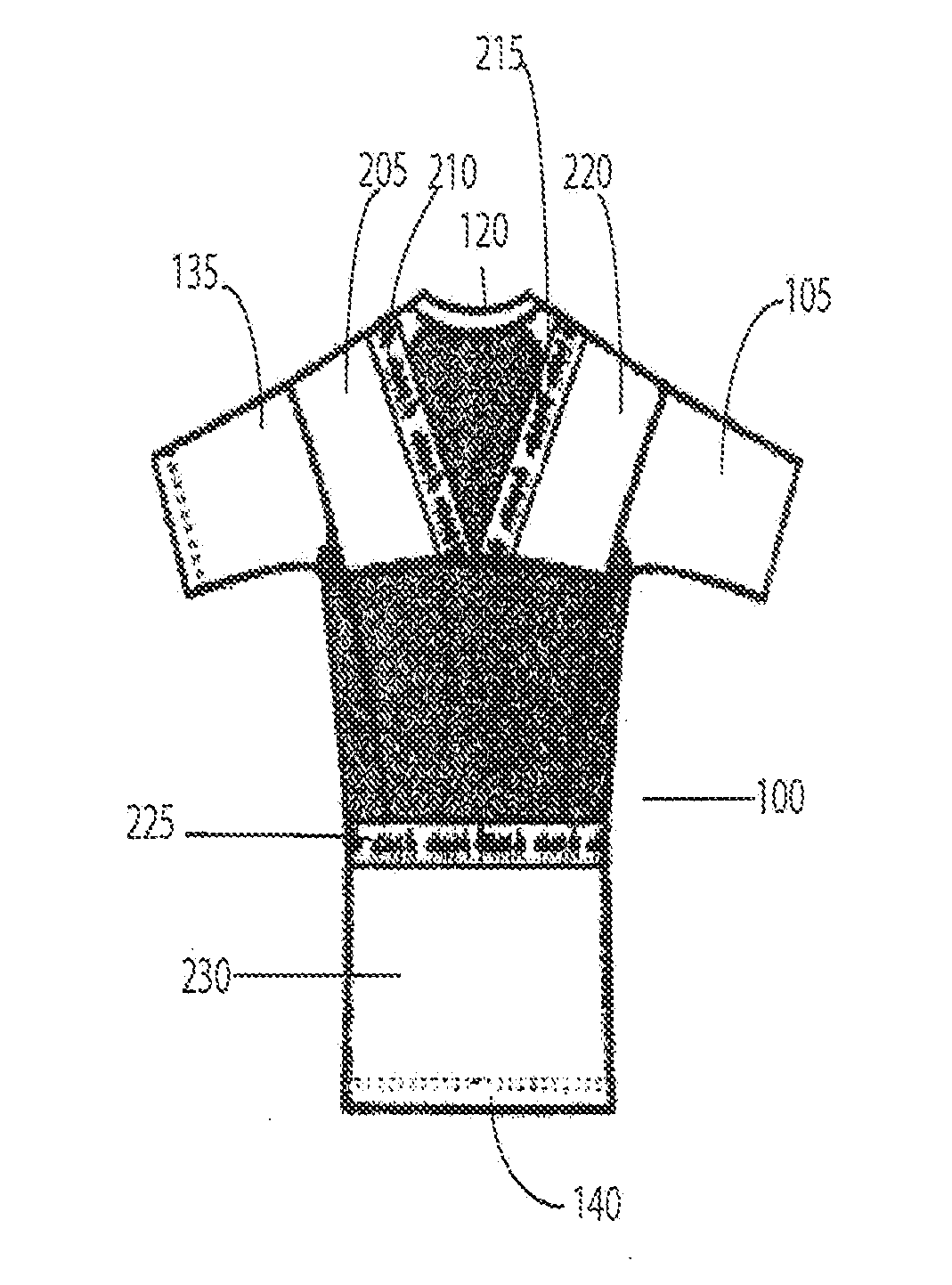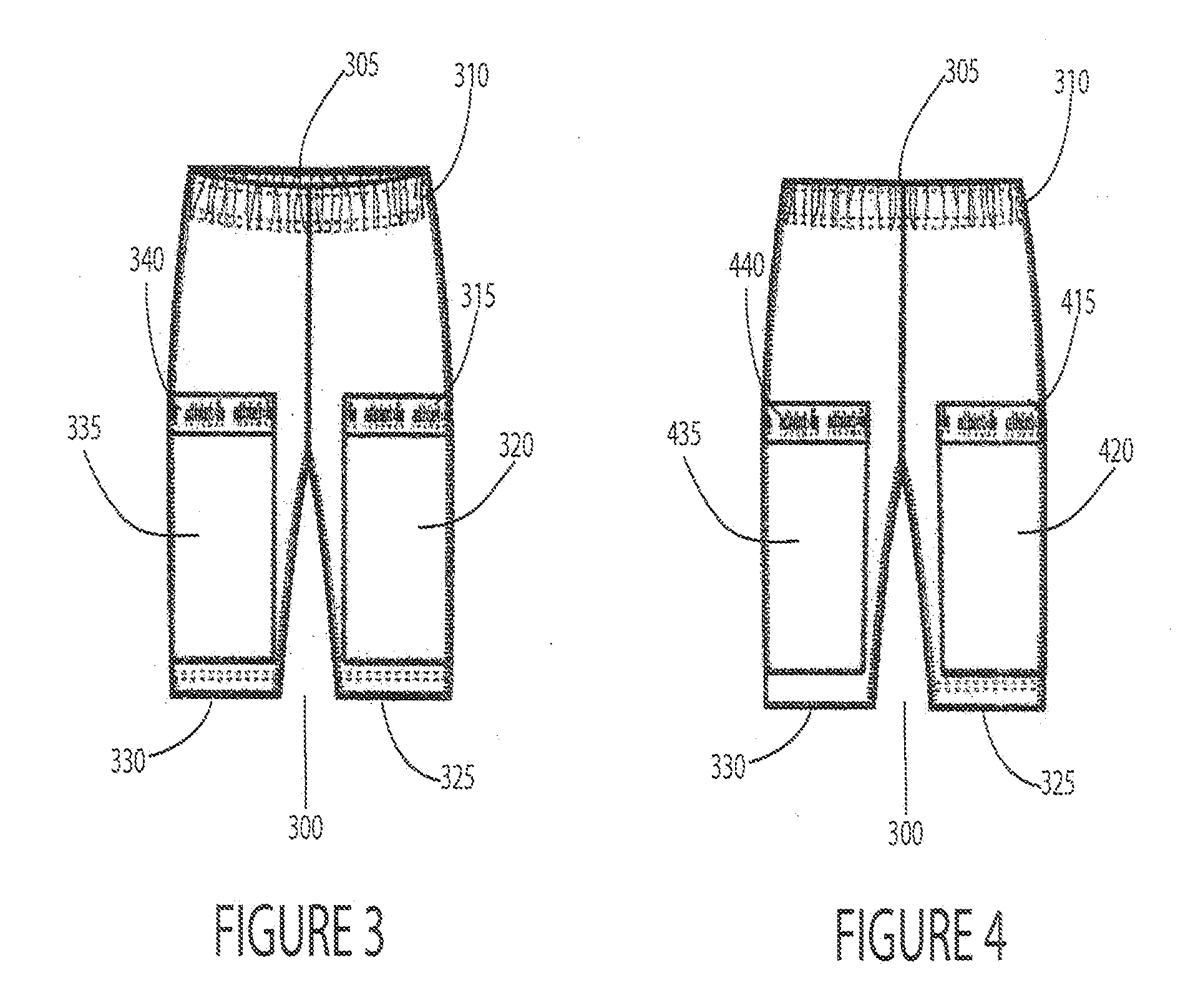[0012]To overcome one or more of the issues described above, Applicant has designed an improved compression garments that provide zoned and gradient compression and that enables
thermal therapy to be applied in numerous locations or on numerous body parts simultaneously and in a manner that enhances the healing and
recovery process. Preferably, such compression garments providing zoned and gradient compression and include a
dual layer of compressive seamless fabric that allows pockets to be defined therebetween at selective locations, accessible through slits or similar openings in the outer layer of the compressive fabric, for easily receiving and securely holding in place thermal media, such as ice or heat packs, that allows the application of targeted, compressive, and uniform thermal therapy to desired body part locations of the wearer of such a garment. Such garments can be used to apply targeted, compressive
heat therapy to numerous body part locations during warm-ups,
rehabilitation or
physical therapy sessions, during exercise or actual sporting events. Similarly, these same garments can be used to apply targeted cold compressive therapy quickly and easily, immediately after exercise or shortly after an injury or other body trauma. The improved pocket design, which provides large pocket spaces between the dual
compression garment layers, combined with the actual compression garments in which the fabric layers provide zoned, gradient, and transitional compression features, provides for an improved
compression garment and one that more easily allows compressive thermal therapy to be applied uniformly to a wider range of muscle groups and other body parts, to expanded coverage of such muscle groups and other body parts—all of which are easily and quickly selectable by the wearer of the garment.
[0013]In a preferred embodiment, improved therapeutic compression garments provide improved compression and thermal therapy benefits not heretofore available—particularly for individuals in the immediate period of time just after injury, trauma, or strenuous athletic activity. In addition, improved pocket designs and pocket locations used with such compression garments have been shown and described herein that provide for more exact and enhanced thermal therapy at strategic muscle / joint /
tendon /
ligament locations and with improved and uniform coverage of desired muscle, joint,
ligament, and
tendon groups that are likely to need and benefit from immediate thermal therapy for warm-ups and stretching before athletic or rehabilitative activities or immediately after an injury, trauma, exercise, or rehab.
[0015]In another preferred embodiment, the design of the compression garments described herein takes
advantage of the seamless technology offered by circular knitting machines to provide a garment that offers maximum comfort and flexibility, particularly when being used for warm-ups or during
physical activity, while also providing maximum, uniform coverage and
efficacy of compressive thermal therapy to desired areas of the wearer's body. Circular or seamless fabric construction does this by creating an equal
surface pressure to keep either hot or cold pack (or sheets, as they may sometimes be called) not only in place but also under compression, and in a manner in which the thermal medium conforms to the contour or physique of the underlying body part being treated. Preferably, pockets for holding the thermal media are created and defined between dual fabric layers of the compression garment.
[0016]Preferably, the dual layers of fabric used to create such compression garments are made using a circular, multi-function knitting
machine. Each of these garments is anatomically designed to create graduated or gradient compression—with highest compression further from the heart and lowest compression closer to the heart. Additionally, the compression is preferably zoned, meaning that support and compression provided by the garment increases and decreases based on its proximity to large muscle groups that are typically targeted for thermal therapy. This is preferably accomplished through the selection and use of certain weaves within the fabric. The balanced
surface pressure that compression garments provide triggers improved
blood circulation, which delivers more
oxygen to working muscles. Better circulation also enables the body to eliminate
lactic acid and other metabolic wastes that can cause
muscle fatigue. The result is an anatomically specific graduated compression garment that fits like a second
skin. Yet further, through the use of transitional areas between zoned compression areas that provide the highest level of compression and non-zoned areas that provide the least level of compression, the garments described herein provide significant flexibility and
range of movement and minimize any restriction to the wearer's movement while wearing such compression garments—whether or not thermal therapy is being applied at the time.
[0017]In a preferred embodiment, the fabric used to create the compression garments described herein are made from high performance, 4-way stretch yarns. This fabric design improves comfort, mobility, and
moisture control in both the inner and outer layer, when the compression garment includes dual layers. Additionally, such fabric allows for an efficient transfer of the thermal therapy to the desired body part of the wearer. In some embodiments, the thickness of the two layers of the garment are substantially the same. In other embodiments, the inner layer of the garment (i.e., the one closest to the
skin of the wearer is thinner than the outer layer of fabric to improve the
thermal transfer between the wearer's body and any thermal packs inserted in pockets between the dual layers of fabric.
[0019]The pocket architecture of the improved compression garment described herein are preferably achieved through the ability of the circular knitting and 4 way stretch fabric to reduce the number of seams needed to create what is referred to as the pocket. Preferably, such pockets are formed and created between the dual layers of compression fabric used to create the compression garment. The outer layer of the garment provides the necessary zoned and gradient compression, which is sufficient to hold ice or heat packs (or similar thermal therapy media) in place and in compression, while still allowing for maximum mobility and comfort for the wearer of the compression garment. Although the fabric used to make the compression garments is described as circular or seamless fabric construction, the compression garments described herein use seams or hems to attached the two layers of the garment together at desired or strategic locations. Such seams or hems are used to create and reinforce the pocket openings, are used to attached the two layers of the fabric together to define the outer confines of different pockets contained between the two layers of garment fabric, and to provide other reinforcement horizontally or vertically along the document. Preferably, such seams or hems are designed and use threads that enable the seam or hem to stretch with the surrounding garment fabric and without inhibiting the elastic, flexibility, stretchability and recoverability of the overall compression garment. Using the space between the dual layers of compression garment fabric to define and place the pockets for holding the thermal media enables pocket openings to be placed in a wide range of locations, depending upon the type of garment involved and the particular uses for which that garment will be used. Such pocket design also allows for the pockets to be larger than traditional pockets, whether they be sewn behind the primary or only layer of fabric used in conventional garments or whether they are attached to the outside surface of a traditional garment. Thus, the present compression garments provide for maximum and targeted coverage for use of thermal therapy. In other words, thermal therapy is not limited to small pocket areas, but to almost any space, and, likewise, to any underlying body part of the wearer that needs application of thermal therapy.
 Login to View More
Login to View More  Login to View More
Login to View More 


